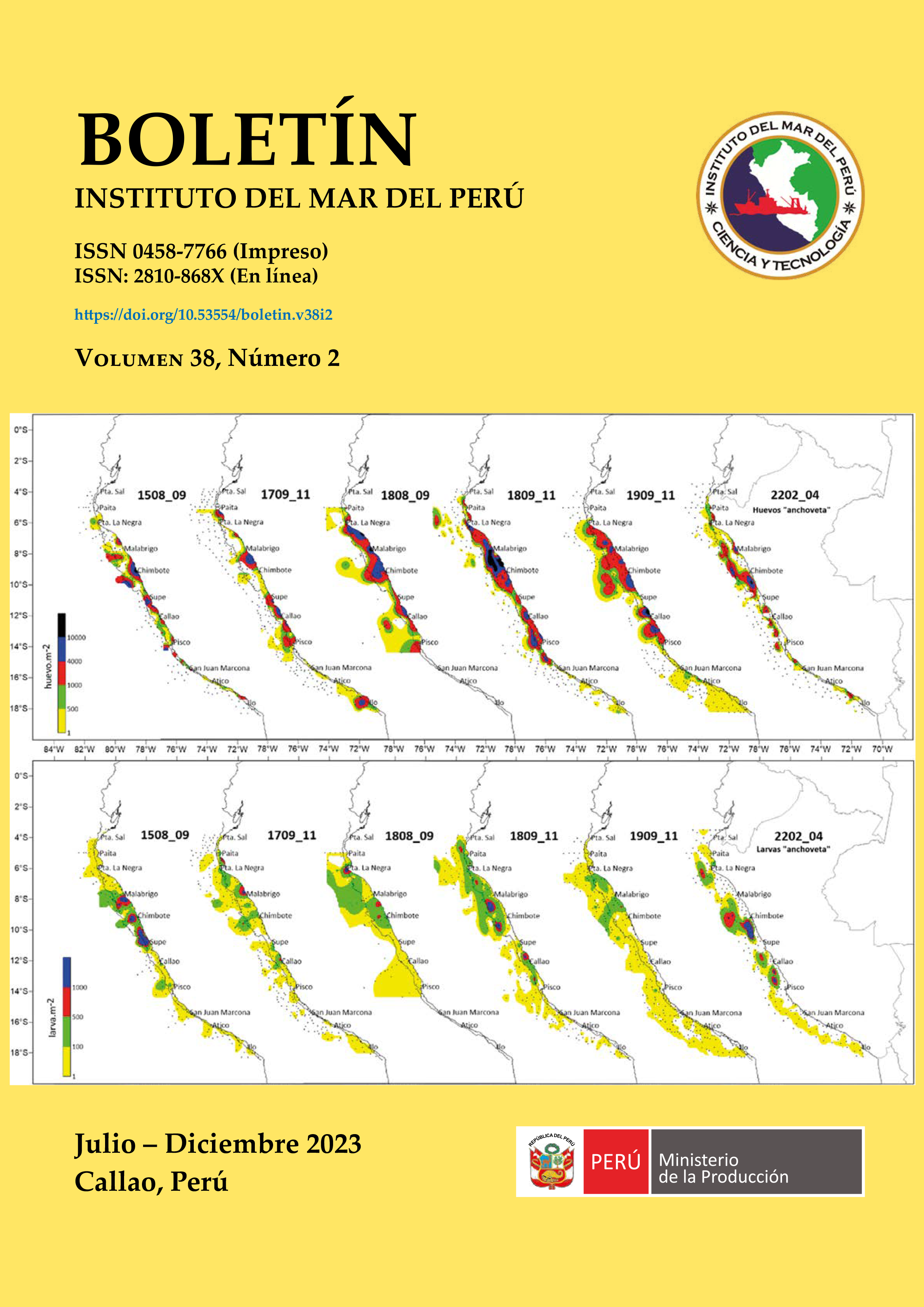Zooplankton, euphausiids, and ichthyoplankton biovolumes during the Hydroacoustic Pelagic Resources Cruise 1809-11 between Punta Mero (Tumbes) and Morro Sama (Tacna)
DOI:
https://doi.org/10.53554/boletin.v38i2.390Keywords:
Biovolumes, Engraulis ringens, Vinciguerria lucetia, EuphausiidsAbstract
This report presents findings from the spring of 2018, focusing on zooplankton biovolumes, ichthyoplankton composition, distribution, and frequency, particularly emphasizing Engraulis ringens and euphausiids eggs and larvae. The study spanned a vast area from Punta Mero (Tumbes) to Morro Sama (Tacna), covering a distance of up to 115 nm. Zooplankton biovolumes ranged widely from 0.005 to 6.76 mL/ m³, with a median of 0.26 mL/m³. Predominant biovolumes, falling within the range of 0.001 to 0.25 mL/m³ (48.0%), were primarily located within the continental shelf. This vast region stretched from Punta Sal to Punta La Negra and from the south of Pimentel to Morro Sama, reaching a maximum distance of 110 nm off the coasts of Paita, Malabrigo, and Pisco. Regarding ichthyoplankton (eggs and larvae), the families Engraulidae and Myctophidae stood out, accounting for 85 % and 50 % of the observed frequencies, respectively. Additionally,
the family Phosichthyidae exhibited a frequency of 45 %. Euphausiids in the calyptopis and furcilia stages were prevalent, with frequencies of 72 % and 75 %, respectively. Among the euphausiids, 4 genera and 14 species were identified, with Euphausia mucronata being the most common species, observed in both adult (34 %) and juvenile (26 %) stages.
Downloads
Alternative Metrics
Metrics
References
Arones, K. (2023). Composición, distribución y abundancia de ictioplancton entre Paita (5°00'S) y bahía Independencia (14°45'S), invierno 2018. Bol Inst Mar Perú, 38(2), 237-248. https://doi.org/10.53554/boletin.v38i2.389
Boden, B. P., Johnson, M. W. & Brinton, E. (1955). The Euphausiacea (Crustacea) of the north Pacific. Bulletin of the Scripps Institution of Oceanography of the University of California, La Jolla, 6(8), 282-394. https://escholarship.org/uc/item/62h3k734
Castillo, R., La Cruz, L., Cornejo, R., Grados, D., Valdez, C. & Chacon, G. (2020). Distribución y biomasa de los principales recursos pelágicos, neríticos y oceánicos en el ecosistema marino peruano obtenidos en los cruceros hidroacústicos, 2018. Bol Inst Mar Perú, 35(2), 185-212. https://hdl.handle.net/20.500.12958/3499
Einarsson, H. & Rojas de Mendiola, B. (1963). Descripción de huevos y larvas de anchoveta (Engraulis ringens J.). Bol. Ins. Recurs. Mar., Callao, I(1),1-23. https://hdl.handle.net/20.500.12958/64
ENFEN. (2018a). Estado de sistema de alerta: No Activo1 (Comunicado Oficial ENFEN n° 08-2018). https://www.dhn.mil.pe/Archivos/oceanografia/enfen/comunicado-oficial/08-2018.pdf
ENFEN. (2018b). Estado de sistema de alerta: No Activo1 (Comunicado Oficial ENFEN n° 05-2018). http://hdl.handle.net/20.500.12816/2391
Gibbons, M. J., Spiridonov, V. A. & Tarling, G. A. (1999). Euphausiacea. 1241 – 1279. In: D. Boltovskoy (Ed.). South Atlantic zooplankton. Backhuys Publishers.
Kramer, D., Kalin, M. J., Stevens, E. G., Thrailkill, J. R. & Zweifel, J. R. (1972). Collecting and processing data on fish eggs and larvae in the California Current Region. NOAA Technical Report NMFS, Circ-370. U. S. Department of Commerce. NOAA. National Marine Fisheries Service. https://spo.nmfs.noaa.gov/sites/default/files/legacy-pdfs/CIRC370.pdf
Moser, H. (1996). The early stages of fishes in the California Current Region. California Cooperative Ocean Fisheries Investigations, 73(3), Atlas Nro. 33, 1505.
Palomares, M. L., Muck, P., Mendo, J., Chuman, E., Gómez, O. & Pauly, D. (1987). Growth of the Peruvian anchoveta (Engraulis ringens), 1953 to 1982. In: D. Pauly, and I. Tsukayama, (Eds). The Peruvian anchoveta and its upwelling ecosystem: three decades of change (PP. 117-141). ICLARM Studies and reviews, Instituto del Mar del Perú (IMARPE). https://hdl.handle.net/20.500.12958/1431
Pinedo, E. & Ayón, P. (2023). Biovolúmenes de zooplancton, ictioplancton y eufáusidos del mar peruano durante la primavera 2017. Bol Inst Mar Perú, 38(2), 215-236. https://doi.org/10.53554/boletin.v38i2.388
Santander, H. (1967). Los Euphausidos en la Zona de Callao – Chimbote y Composición General del Zooplancton en agosto de 1961 [Tesis de Bachiller en Ciencias Biológicas]. Universidad Nacional Mayor de San Marcos. Facultad de Ciencias Escuela de Ciencias Biológicas.
Santander, H. & Sandoval de Castillo, O. (1973). Estudio sobre las primeras etapas de vida de la anchoveta. Informe Inst. Mar del Perú Callao, 41, 1-30. https://hdl.handle.net/20.500.12958/269
Downloads
Published
How to Cite
Issue
Section
License
Copyright (c) 2023 Boletin Instituto del Mar del Perú

This work is licensed under a Creative Commons Attribution 4.0 International License.










